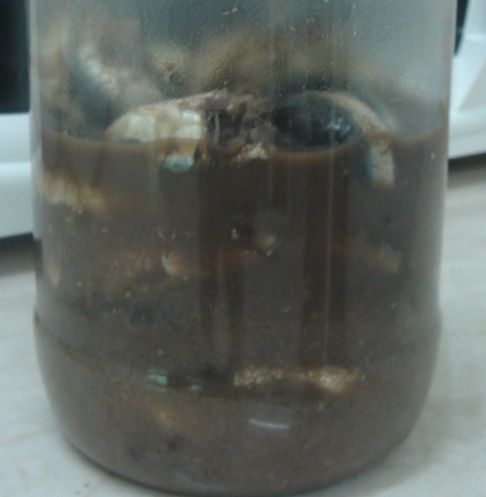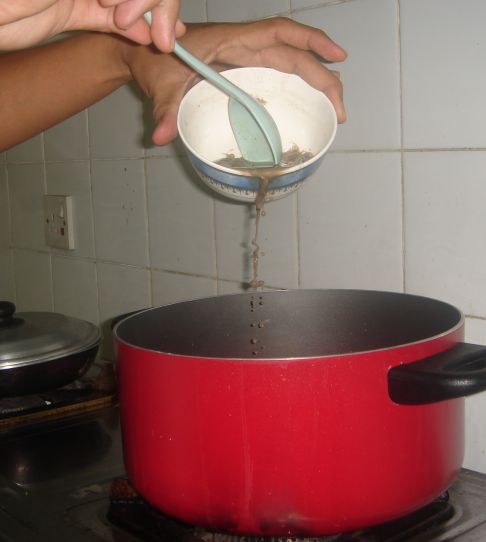(This was written and blogged when I was in the Sultanate of Oman, of which during my brief stay, I craved for bugguong (fermented fish/fish paste) like no other. In that particular place, Sohar City, where we used to stay, no bugguong was in sight. At that particular time. But nowadays, I was duly informed that a newly built big supermarket/mall has rows of bottled bugguong paste in its "Asian" section, to the relief of the many homesick Ilokanos in the area.
This is a follow-up to my entry about my attempt at bugguong-making in an Arab land, in desperation.)
And so I have my own precious home-brewed bugguong at last. Now, I could content myself with a real bugguong to tinker with my simple binugguongan recipes.

So, at last, I should not worry about scouring stores for that elusive bottled instant bugguong which is, by the way, "in vogue" in most parts of the Philippines, Ilocos Region included. Surely, people is used to these instant mix things like instant sampaloc mix, instant kamias mix, instant ginisa flavor mix, instant meaty flavor mix, instant gata mix and so many other powderized and solidified mixes and other bizarre (but admittedly, nifty and practical) compact concoctions that they now prefer these to, well, instantly and without much ado, flavor their cooking. And bugguong is obligatorily included courtesy of the bottled liquefied brew. No more of the bagas of flesh, fishbone and all. Gone also are the canned bugguongs which proliferated the market in the past (remember the famous "naimas ken nabanglo" CK Bagoong? This was the most popular canned whole bugguong when I was younger). Although, of course, you can still have a sinukat or a jar of whole bugguong straight from the bugguong vendors who display their bugguong in big plastic vats and some still sealed in plastic container inside huge straw bags. They`re still there, the bugguong traders as there are still bugguong factories in Lingayen, Dagupan or Balayan (in fact, the enormously popular bottled bugguongs are also made by these big bugguong manufacturers). You'll just have to be keen enough and be wary when you buy sinukat or tingi as some, or most, bugguong vendors has this vicious practice of diluting their wholesome bugguong with boiled tap water just to bloat the quantity of their bugguong. This is one disgusting "business strategy" of most small and big vendors in the Philippines. They dilute your bugguong, they put formalin in your meat and vegetables, they sell you stale and expired and substandard goods, etc. This despite you paying the price they want. so, if you buy fresh bugguong or other stuff, you better have a suki that you can trust.
Instant bugguong is really the easy way to have your dinengdengs and pinakbets. But if you really want a hearty inabraw or pakbet that you can truly savor and enjoy because it's a labor of love, you should use fresh whole bugguong.
And do the process of panamagbugguong act--the panagsegseg.
The first of which is of course, you boil some cups of water in a pan. you can calculate the right amount of water according to the type of dinengdeng that you want to cook, or in the amount of veggies, or even in the kind of veggies. Soupy or broth types, naturally, need more water. Pinakbet types require less or even nothing (some extremely dry pinakbets really need only the bugguong juice and the vegetables' own sweet juice to cook).
The right amount of bugguong also depends on the above considerations. Pinakbet types require more, though. But be careful that it won't become too salty. A salty pinakbet, especially if cooked dry, cannot be "remedied" by adding some water later to neutralize its saltiness. Not if you really preferred it dry in the first place. Mind you, adding water to try to reduce saltiness will spoil your precious pinakebbet.
When the water is bubbling, scoop up boiling water into the bugguong bowl. The hot water will actually cook the bugguong and loosen the fermented fish in it so you could separate flesh and guts from fishbone. Use the ladle to squash, mash and squeeze the fish, fishhead and all, until its flesh and other fish parts turn into a kind of a puree and blend with the mixture.


Then with utmost care, slowly and with calculated balancing act, pour in the liquid into the pan. Use the ladle to trap or filter the fishbone while pouring the liquid to prevent fishbone and other thorny bony bits to fall into the pan. Others use a fine mesh to filter thereby saving them of accidentally pouring segseg or remnants. But then, again, we are doing here the traditional way of panagsegseg, no easy shortcuts, please, use the ladle and test and prove your Ilokano skills of the panagsegseg.

First pouring will not at all pour the fleshy liquid so you've got to ladle up some more hot water into the bowl and segseg it again, pour the segregated liquid again, until what's left in the bowl are only fishbones and dregs.



Let the bugguong broth simmer for some minutes, just give it time to boil to cook in its juice, in its own salty sweet essence. This way, to eradicate its angdod or for its peculiar bugguongy smell to evaporate and turn into a heavenly dinengdeng/pakbet scent. Then you can now blend your vegetables and other ingredients for another savory and wholesome binugguongan mélange.
This is a follow-up to my entry about my attempt at bugguong-making in an Arab land, in desperation.)
And so I have my own precious home-brewed bugguong at last. Now, I could content myself with a real bugguong to tinker with my simple binugguongan recipes.

Instant bugguong is really the easy way to have your dinengdengs and pinakbets. But if you really want a hearty inabraw or pakbet that you can truly savor and enjoy because it's a labor of love, you should use fresh whole bugguong.
And do the process of panamagbugguong act--the panagsegseg.
The first of which is of course, you boil some cups of water in a pan. you can calculate the right amount of water according to the type of dinengdeng that you want to cook, or in the amount of veggies, or even in the kind of veggies. Soupy or broth types, naturally, need more water. Pinakbet types require less or even nothing (some extremely dry pinakbets really need only the bugguong juice and the vegetables' own sweet juice to cook).
The right amount of bugguong also depends on the above considerations. Pinakbet types require more, though. But be careful that it won't become too salty. A salty pinakbet, especially if cooked dry, cannot be "remedied" by adding some water later to neutralize its saltiness. Not if you really preferred it dry in the first place. Mind you, adding water to try to reduce saltiness will spoil your precious pinakebbet.
When the water is bubbling, scoop up boiling water into the bugguong bowl. The hot water will actually cook the bugguong and loosen the fermented fish in it so you could separate flesh and guts from fishbone. Use the ladle to squash, mash and squeeze the fish, fishhead and all, until its flesh and other fish parts turn into a kind of a puree and blend with the mixture.


Then with utmost care, slowly and with calculated balancing act, pour in the liquid into the pan. Use the ladle to trap or filter the fishbone while pouring the liquid to prevent fishbone and other thorny bony bits to fall into the pan. Others use a fine mesh to filter thereby saving them of accidentally pouring segseg or remnants. But then, again, we are doing here the traditional way of panagsegseg, no easy shortcuts, please, use the ladle and test and prove your Ilokano skills of the panagsegseg.

First pouring will not at all pour the fleshy liquid so you've got to ladle up some more hot water into the bowl and segseg it again, pour the segregated liquid again, until what's left in the bowl are only fishbones and dregs.



Let the bugguong broth simmer for some minutes, just give it time to boil to cook in its juice, in its own salty sweet essence. This way, to eradicate its angdod or for its peculiar bugguongy smell to evaporate and turn into a heavenly dinengdeng/pakbet scent. Then you can now blend your vegetables and other ingredients for another savory and wholesome binugguongan mélange.














0 comments:
Post a Comment